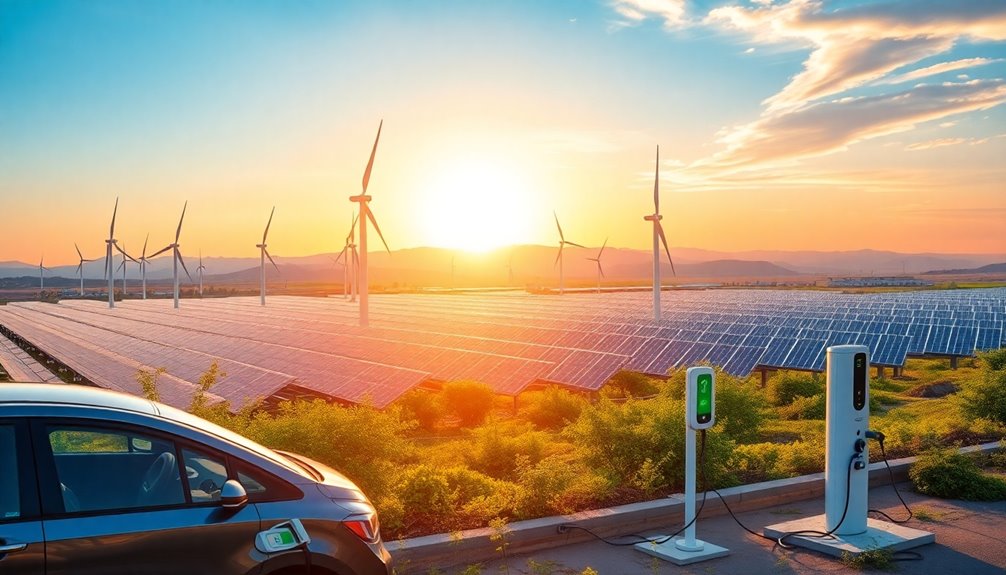Integrated energy system models are vital for helping you achieve decarbonization. They work by coupling various sectors, improving energy efficiency, and assessing lifecycle emissions to minimize carbon footprints. By integrating vehicle-to-grid technology, these models allow electric vehicles to act as mobile energy storage, stabilizing the grid during peak times. This approach optimizes energy flow and enhances reliability. There's much more to explore about how these systems transform our energy landscape and support sustainability.
Key Takeaways
- Integrated energy system models optimize resource utilization and reduce emissions, crucial for achieving decarbonization goals in a cleaner energy landscape.
- Sector coupling enhances energy efficiency, integrating heating, cooling, and transport sectors to minimize waste and streamline renewable energy use.
- Lifecycle emissions assessments in energy-carbon coupling models help manage carbon output alongside energy flows, supporting national carbon reduction targets.
- Vehicle-to-grid integration allows electric vehicles to function as mobile energy storage, stabilizing the grid and improving efficiency during peak demand periods.
- HELICS framework facilitates co-simulation of diverse energy systems, enhancing understanding and optimization of energy flows and emissions for a sustainable future.

As the world shifts towards cleaner energy, integrated energy system models are becoming essential for optimizing our energy landscape. These models combine multiple energy sources and sectors to enhance efficiency and reduce emissions, making them pivotal in today's decarbonization efforts. By connecting heating, cooling, and transport sectors, you can utilize excess energy more effectively, thereby minimizing waste and maximizing resource use.
Energy hubs play a central role in this integration, coordinating various energy forms and conversion processes. They help absorb more renewable energy by managing supply and demand variability, allowing you to harness resources like solar, wind, and hydrogen more efficiently. Through advanced technologies such as power-to-gas and combined cooling, heating, and power systems, you can improve energy conversion and storage, ensuring reliability even with the volatility of renewable sources. Moreover, the energy-carbon coupling model provides a framework for analyzing the interactions between energy use and carbon emissions.
Energy hubs are vital for managing renewable resources, enhancing efficiency and reliability in our integrated energy systems.
Lifecycle emissions are crucial when assessing the sustainability of these integrated systems. By employing energy-carbon coupling models, you can efficiently manage carbon emissions alongside energy flow, supporting national carbon reduction targets. A key goal of integrated energy systems is decarbonization through optimized energy use across sectors, which ultimately leads to a lower carbon footprint.
Sector coupling enhances energy efficiency and flexibility, simplifying the integration of renewable sources. This not only encourages energy reuse, like waste heat but also ensures greater grid flexibility, crucial for balancing supply and demand. Vehicle-to-grid (V2G) technology exemplifies this integration, allowing electric vehicles to serve as mobile energy storage units that can supply power back to the grid. This capability helps stabilize the grid during peak demand periods, further enhancing the overall efficiency of energy systems.
Incorporating modeling and simulation tools like the HELICS framework allows you to co-simulate multiple energy systems, simplifying complex processes. By leveraging these integrated energy system models, you can pave the way toward a sustainable, low-carbon future.
Frequently Asked Questions
How Do Integrated Energy Systems Impact Local Economies?
Integrated energy systems significantly boost local economies by creating jobs in renewable energy sectors and attracting investments.
You'll notice regional growth as these systems promote economic clusters. By reducing energy costs through efficient renewable use, they enhance financial sustainability.
Additionally, these systems foster innovation and flexibility, allowing communities to adapt and thrive.
Ultimately, embracing integrated energy solutions positions you to benefit from a more resilient and sustainable economic future.
What Are the Barriers to Implementing Sector Coupling?
Imagine trying to fit a square peg into a round hole; that's how implementing sector coupling feels with its many barriers.
You face technological inefficiencies, high costs, and outdated infrastructure that can stifle progress.
Regulatory confusion and a lack of financial incentives add to the struggle, while societal resistance and limited public awareness further complicate the transition.
To succeed, you'll need to navigate these challenges with creativity and determination.
How Can Consumers Participate in Vehicle-To-Grid Programs?
You can participate in vehicle-to-grid (V2G) programs by enrolling in opt-in initiatives offered by your utility.
First, check if your electric vehicle (EV) supports bidirectional charging, then find a compatible charging system.
By charging during off-peak hours and selling energy back during peak demand, you'll save on electricity bills.
Keep informed about incentives, and engage with educational resources to maximize your benefits and contribute to a more resilient energy grid.
What Technologies Are Essential for Effective Energy Integration?
To achieve effective energy integration, you'll need key technologies like heat pumps for efficient heating, and power-to-X technologies that convert electricity into hydrogen or synthetic fuels.
Energy storage solutions like batteries and thermal storage are crucial for balancing supply and demand.
Digitalization plays a vital role in synchronizing these systems.
Additionally, smart grid investments are essential for managing distributed energy resources and ensuring seamless interactions between different energy sectors.
How Do Lifecycle Emissions Vary by Energy Source?
Have you ever wondered how much your energy choices impact the planet?
Lifecycle emissions vary greatly by energy source. For instance, solar and wind power emit around 6 and 4 grams of CO2 equivalent per kilowatt-hour, respectively, while fossil fuels like natural gas and coal can reach staggering levels of 486 and even higher.
Conclusion
In conclusion, integrated energy system models offer a powerful approach to decarbonization through sector coupling, lifecycle emissions analysis, and vehicle-to-grid integration. By visualizing these interconnected systems, you can see how each component works together to reduce emissions and enhance energy efficiency. This holistic perspective helps you grasp the importance of collaboration across sectors, making it clear that a coordinated effort is essential for achieving our climate goals. Together, we can pave the way for a sustainable future.









